
Cancellation Emails: Examples, Templates & Best Practices [2026]
These days, getting cancelled can mean a lot of things, including a trending scandal, a viral takedown, or a customer clicking unsubscribe, skipping your event, or calling off a booking.
In the inbox, though, cancellation doesn’t equal drama but opportunity.
Whether someone cancels an order, a subscription, or their spot at your event, your response matters. That’s why a clear cancellation email can turn a frustrating moment into a positive experience, making it easier for your customers to come back when they’re ready. The same applies when you need to cancel something on your side due to unexpected reasons.
In this guide, we’ll cover everything you need to know about cancellation emails, from setup to strategy. You’ll find best practices, templates, and real-life examples to help you write emails that are both helpful and engaging.
Keep Calm and Cancel On
Handle email cancellations with an intuitive email marketing platform.
Try MoosendWhat is a Cancellation Email?
This is a message to notify someone that a planned action, service, event, or order has been canceled. Its main goal is to keep the recipient informed, reduce confusion, and maintain trust by clearly explaining what’s being called off and what happens next.
When written well, these communications are professional and transparent, reassuring the customer or contact that their request has been received and handled properly.
What Should Your Cancellation Email Include?
A good cancellation notice should be short, informative, and hassle-free. Here’s what to include to make sure your message hits the mark:
- A clear subject line: Let the recipient know exactly what the email is about.
- Confirmation of the cancellation: State what’s been cancelled and when it takes effect.
- Relevant details: Add dates, order numbers, account info, refund status, or access expiration.
- Optional explanation: Briefly explain the reason, if necessary or helpful.
- Next steps: Offer rescheduling options, alternative dates/products/plans, or ways to return.
- Support contact information: Provide the recipient with an easy way to contact you if they have questions, such as via email, chat, or a phone number.
If additional steps are required, ensure that you provide a detailed description of the entire cancellation process.
When Should You Send a Cancellation Email?
Depending on the type, you should send a cancellation email as soon as a request is made or an unexpected event happens. Some common instances include:
- After a customer cancels an order, subscription, or appointment.
- If you’re canceling an event due to weather, logistics, or internal decisions.
- When a product is discontinued or out of stock after purchase.
- If a service can’t be delivered due to technical issues or policy changes.
- To confirm a cancellation request and provide closure.
The sooner you contact your customer, the better the experience, especially if you include key details like refunds, support contacts, and next steps.
How to Set Up a Cancellation Email
Cancellation emails are typically transactional messages, meaning they’re triggered by a specific user action, like cancelling an order, booking, subscription, or membership.
To ensure these messages go out automatically at the right moment, you’ll need to set up your workflows through your email platform or automation tool.
- Create a trigger: Define the exact event that should launch the email (e.g., user cancels an order, unsubscribes from a plan, removes a booking). This trigger is often connected to your website, app, or eCommerce store.
- Design the email: Keep the design minimal, mobile-friendly, and focused on clarity. Use a transactional template or a custom layout with all the necessary details. Plain text emails are also common, so the reader focuses on the message rather than getting distracted by visuals.
- Personalize the message: Use dynamic fields, such as name, order number, or cancellation date, to make the message feel more personal, even if it’s automated.
- Test the automation: Always test the trigger and email to ensure they fire correctly, land in the inbox, and display properly across devices.
- Monitor performance: While transactional emails typically have high open rates, it’s still worth checking delivery, open, and click rates, especially if you include CTAs or upsell options.
Types of Cancellation Emails
Not all cancellations are the same, and neither are the emails that follow. Depending on what’s canceled, the tone, structure, and content of your message will vary.
Below, we’ll explore the most common types, along with cancellation email templates and real-life examples to help you handle each situation professionally.
1. Order cancellation emails
These emails confirm that a customer’s order has been canceled, either at their request or due to an issue on your end. These emails provide clarity, prevent confusion, and offer a chance to maintain trust, even when the purchase doesn’t go through.
Send an order cancellation email as soon as the cancellation is processed. Common scenarios include:
- The customer canceled their order before fulfillment.
- The product is currently out of stock or has been discontinued.
- There was a payment failure or suspected fraud.
- You had to cancel the order due to internal issues (e.g., shipping delays, incorrect pricing).
Timely communication helps reassure the customer and reduces inbound support requests.
Order confirmation email template
Hi [Customer Name],
We wanted to let you know that your order #[Order Number] has been successfully canceled.
Order details:
- Order Date: [Date]
- Item(s): [Product Name or Summary]
- Refund: [Refund amount and timeline, if applicable]
If you didn’t request this cancellation or have any questions, please feel free to reach out to our support team at [Support Email or Link].
We’re here to help, and we look forward to serving you again soon.
Best regards,
[Your Brand]
Example: Amazon
This Amazon order cancellation email is direct and informative. It confirms the cancellation, includes order details and refund timing, and provides a help link for further support. The clean layout and clear email copy help the customer understand exactly what happened and what to expect next.
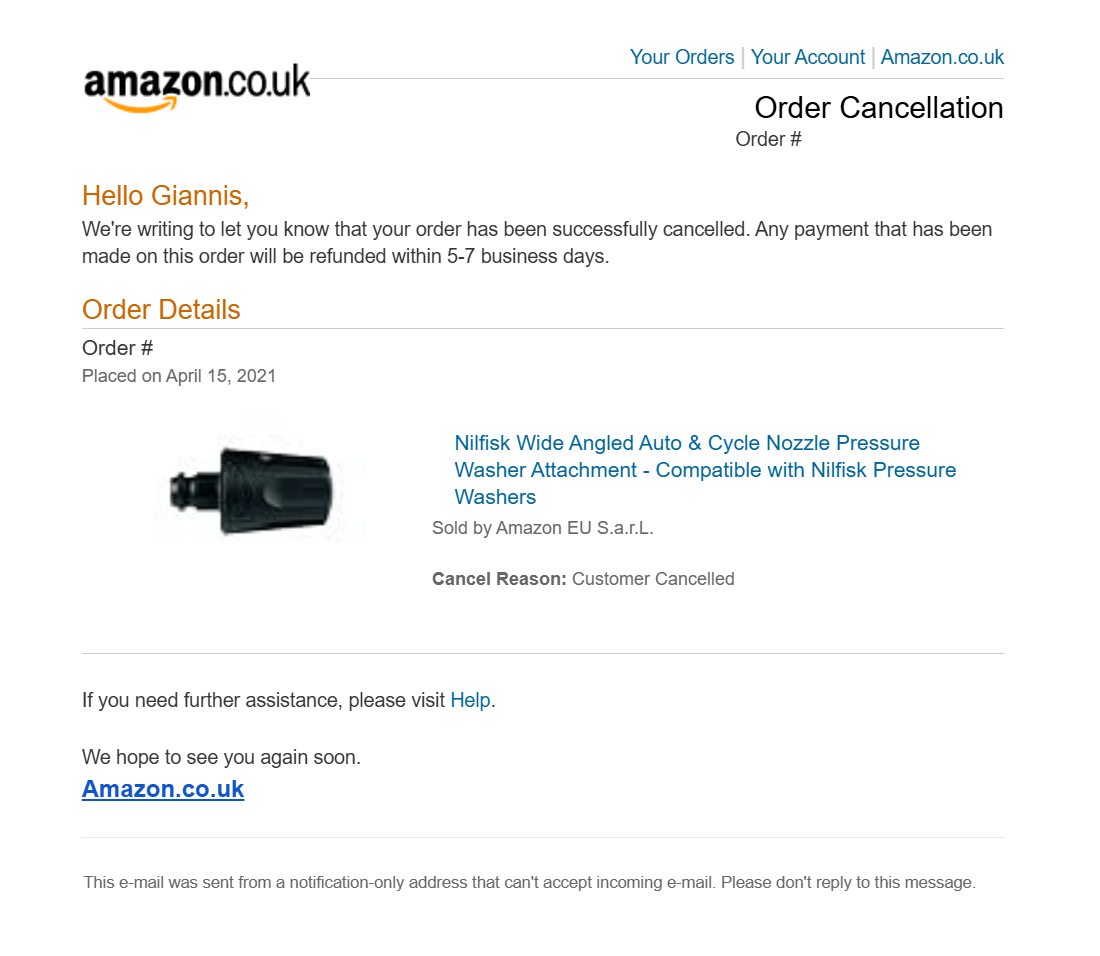
2. Event cancellation messages
These messages are a key part of every successful event marketing strategy. They notify attendees that a planned event, whether physical or virtual, has been canceled, postponed, or rescheduled.
As a result, they set expectations early, prevent confusion or no-shows, and show that your brand takes communication seriously.
Send an event cancellation email as soon as the decision is made. Ideally, this should occur well before the scheduled start time to allow recipients sufficient time to adjust.
Common reasons include:
- Unforeseen circumstances (weather, illness, technical issues).
- Low registrations or budget changes.
- Speaker cancellations or venue problems.
Event cancellation template
Hi [Customer Name],
We’re reaching out to let you know that [Event Name], originally scheduled for [Date], has been canceled.
We know this may be disappointing, and we genuinely appreciate your interest and support.
If you’ve already registered, you’ll receive a full refund within [X] business days.
We look forward to welcoming you to a future event soon. Stay tuned for updates!
If you have any questions, please don’t hesitate to contact us at [Customer Support Team Email].
Tip: If you’re rescheduling the event, replace “canceled” with “postponed” and add a CTA, such as “Save My Spot for the New Date.”
Example: Circles
This email adopts a heartfelt and transparent approach to announce the cancellation of the Circles Conference 2021. It explains the reasons behind the decision, offers refund and transfer options, and maintains a hopeful tone by looking ahead to the future. Long but well-structured, it feels genuine and reassuring.
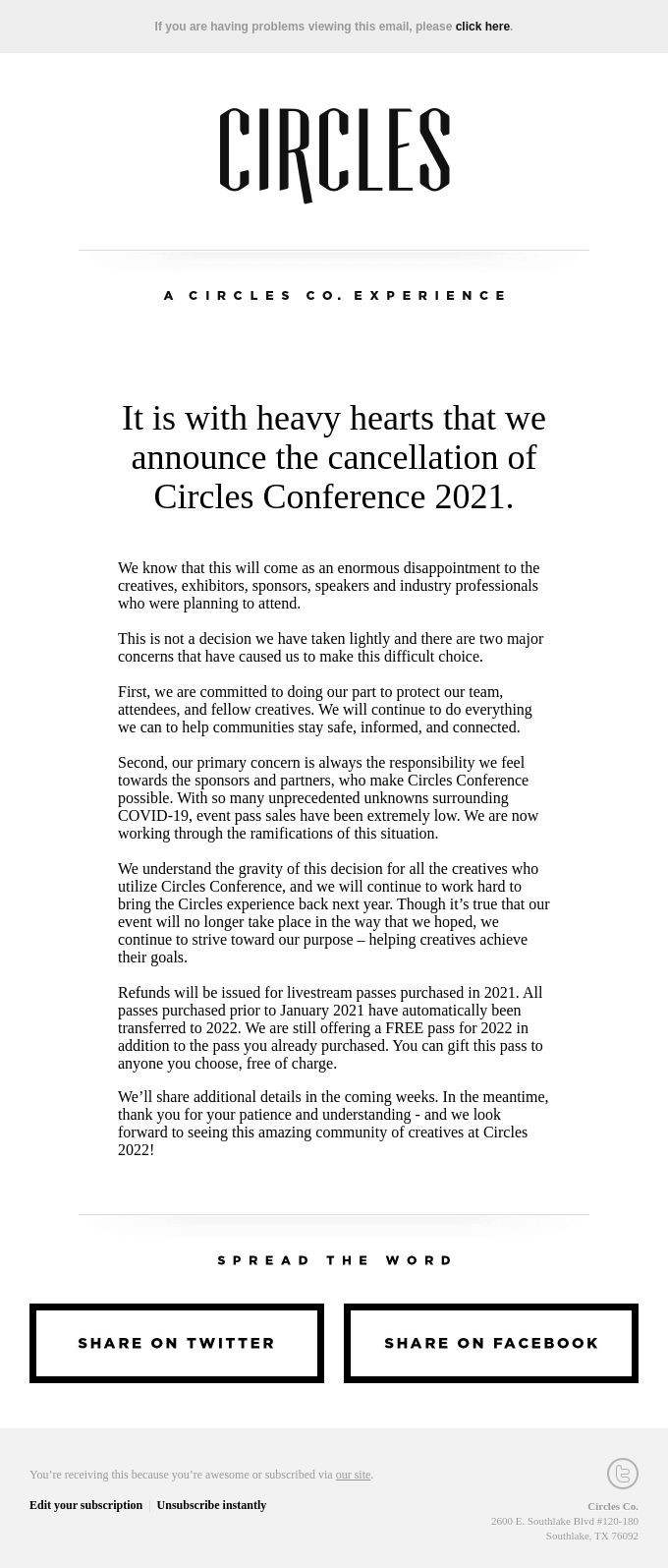
Additional resources
- Event Invitation Email Examples [+Useful Tips]
- Best Event Reminder Templates [with Tips]
- Engaging Event Email Subject Lines [Examples & Tips]
- Free Event Email Newsletter Templates
3. Subscription cancellation emails
These messages are due when a customer ends or pauses their subscription, whether it’s for a product box, streaming service, software, or membership. They confirm the action and offer valuable information on what happens next.
For example, they should clearly state that the subscription has ended and outline what the customer can expect (e.g., the last billing date, final access, and any refunds).
This is also an excellent opportunity to re-engage users or offer alternative options, such as pausing instead of canceling, switching to a lower-tier plan, or sharing feedback.
Subscription or service cancellation template
We’ve confirmed the cancellation of your [Service Name] subscription. Your access will remain active until [End Date], and you won’t be charged again.
If you change your mind, you can restart your subscription at any time from your account settings.
We’d love to hear your thoughts. Just reply to this email and let us know how we can do better.
Thank you for being part of our community.
[Company Name]
Example: Duolingo
Duolingo keeps it short and friendly, using playful language and visuals to soften the cancellation message. It confirms the subscription end clearly while leaving the door open with a bright CTA. The tone is light and reassuring, encouraging users to return at any time.
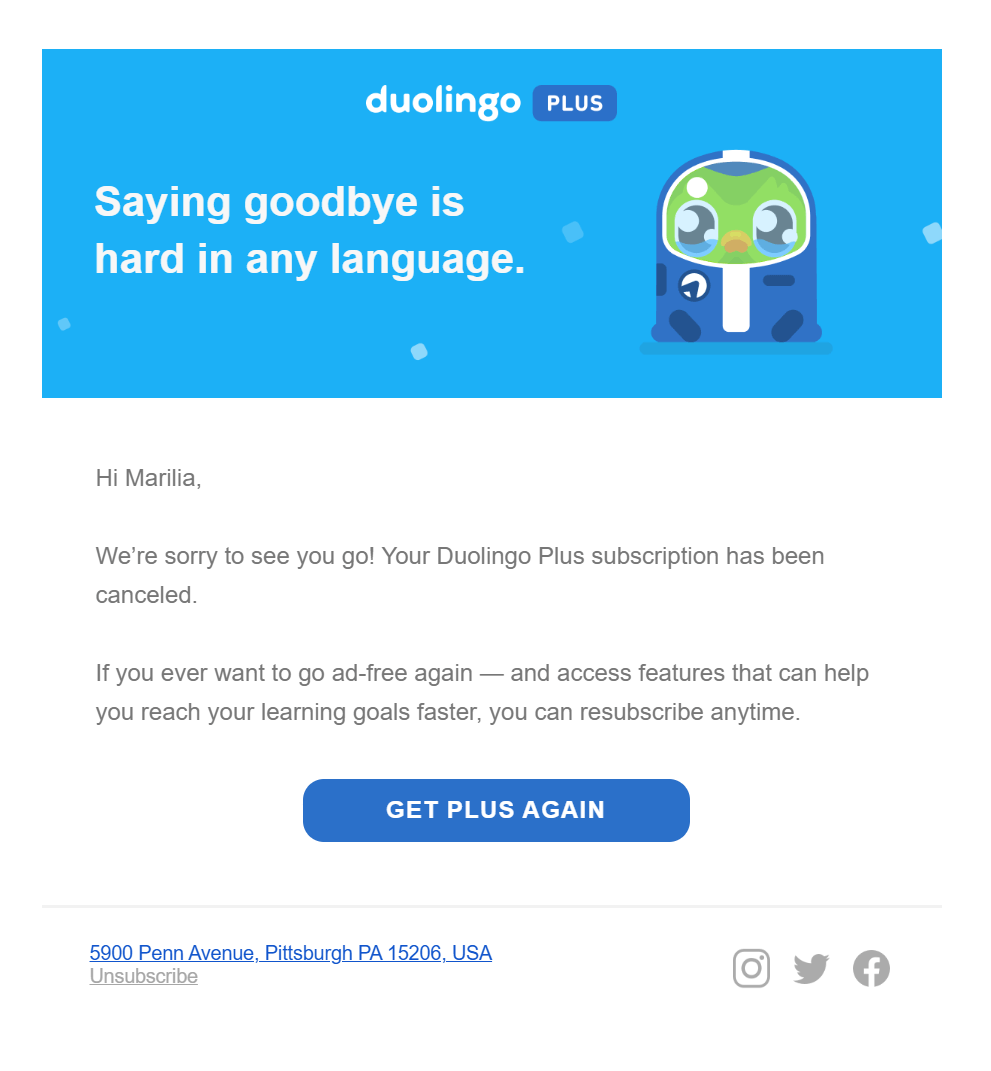
4. Appointment & reservation cancellations
When a customer cancels or reschedules a booking, meeting, or reservation, including appointments for haircuts, dinners, demos, or doctor’s visits, they should receive a confirmation of the cancellation.
The goal is to confirm the cancellation, clarify any further actions, and leave the door open for rescheduling.
Appointment cancellation template
Hi [First Name],
Your appointment on [Date/Time] has been successfully canceled.
If you’d like to reschedule, you can do so at any time by clicking the link below.
[Reschedule Appointment]
We hope to see you again soon!
[Company Name]
Tip: Use clear calls-to-action for rescheduling and make sure the timing, location, and cancellation details are easy to read.
Template example
This appointment cancellation email message, created with Moosend’s editor, confirms the cancellation, offers a direct rescheduling option, and maintains a helpful tone. The red CTA stands out, making it simple for users to take action without feeling lost or overwhelmed.
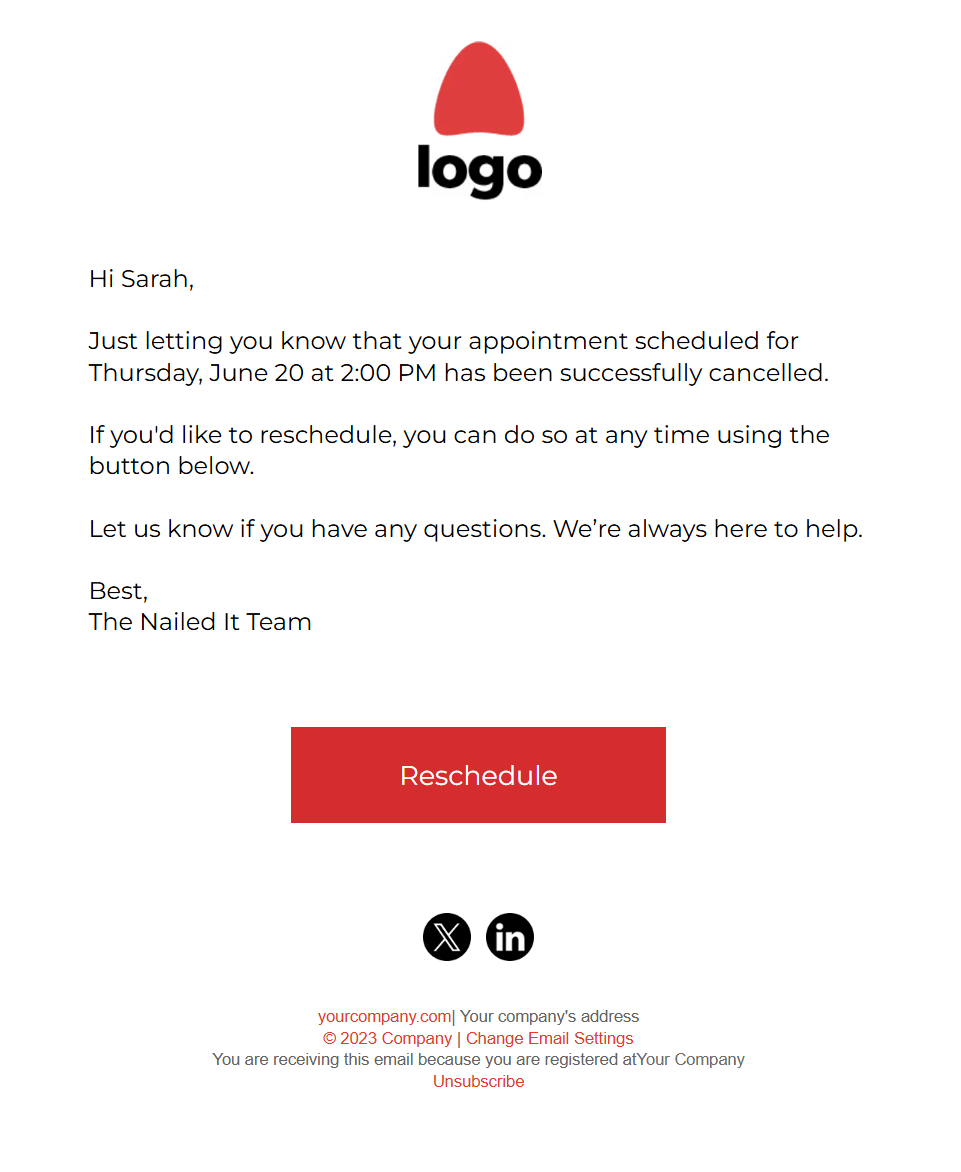
5. Booking cancellation message
Booking cancellation emails confirm that a reservation, such as a hotel stay, car rental, table booking, or travel service, has been canceled. These emails provide reassurance, set expectations, and help avoid confusion at check-in or arrival.
Send your email immediately after the cancellation is processed. This applies whether the customer cancels the booking themselves or the business does due to changes in availability or policy. Prompt communication shows professionalism.
Also, include all relevant details, such as the original booking information, cancellation date, refund status (if applicable), and instructions on what the customer should do next.
Booking cancellation template
Hi [First Name],
This is to confirm that your booking for [Service/Location] on [Date] has been canceled.
If any charges were made, you’ll receive a full refund within [X] business days.
Need to rebook? You can easily reserve a new date by clicking the link below.
[CTA: Rebook Now]
Thanks for choosing [Company Name]. We look forward to welcoming you again soon.
Example: Booking.com
This booking cancellation example from Booking.com is informative and polite. It acknowledges the cancellation request, explains the policy, and shows a willingness to help by contacting the property. Even with a strict policy, the tone stays customer-focused and helpful, guiding users toward support and possible solutions.

6. Membership cancellations
These emails are triggered when a user has ended their membership with a service, club, organization, or community. These emails provide closure and help maintain a positive relationship, even after the customer leaves.
Whether it’s a gym, loyalty program, association, or VIP club, members expect confirmation that outlines the changes taking effect from this point forward, such as loss of access, termination of benefits, or account deactivation.
Membership cancellation template
Hi [First Name],
Your [Membership Name] has been successfully canceled as of [Date]. We’re grateful for the time you spent with us and hope you enjoyed the experience.
If you change your mind, rejoining is easy. Just click below to reactivate your membership.
[CTA: Reactivate Membership]
Before you go, would you mind answering [a few quick questions]? Your feedback helps us make things better.
Thank you,
[Company Name]
Tip: If you offer different tiers or a pause option, be sure to mention them here. It can help retain users who may simply need a break.
Example: Audible
This cancellation email example from Audible is clear and informative. It confirms the cancellation date, explains what remains accessible, and offers a way to rejoin. The tone is friendly and supportive, with helpful links and a standout CTA that makes managing or restarting the membership easy and stress-free.
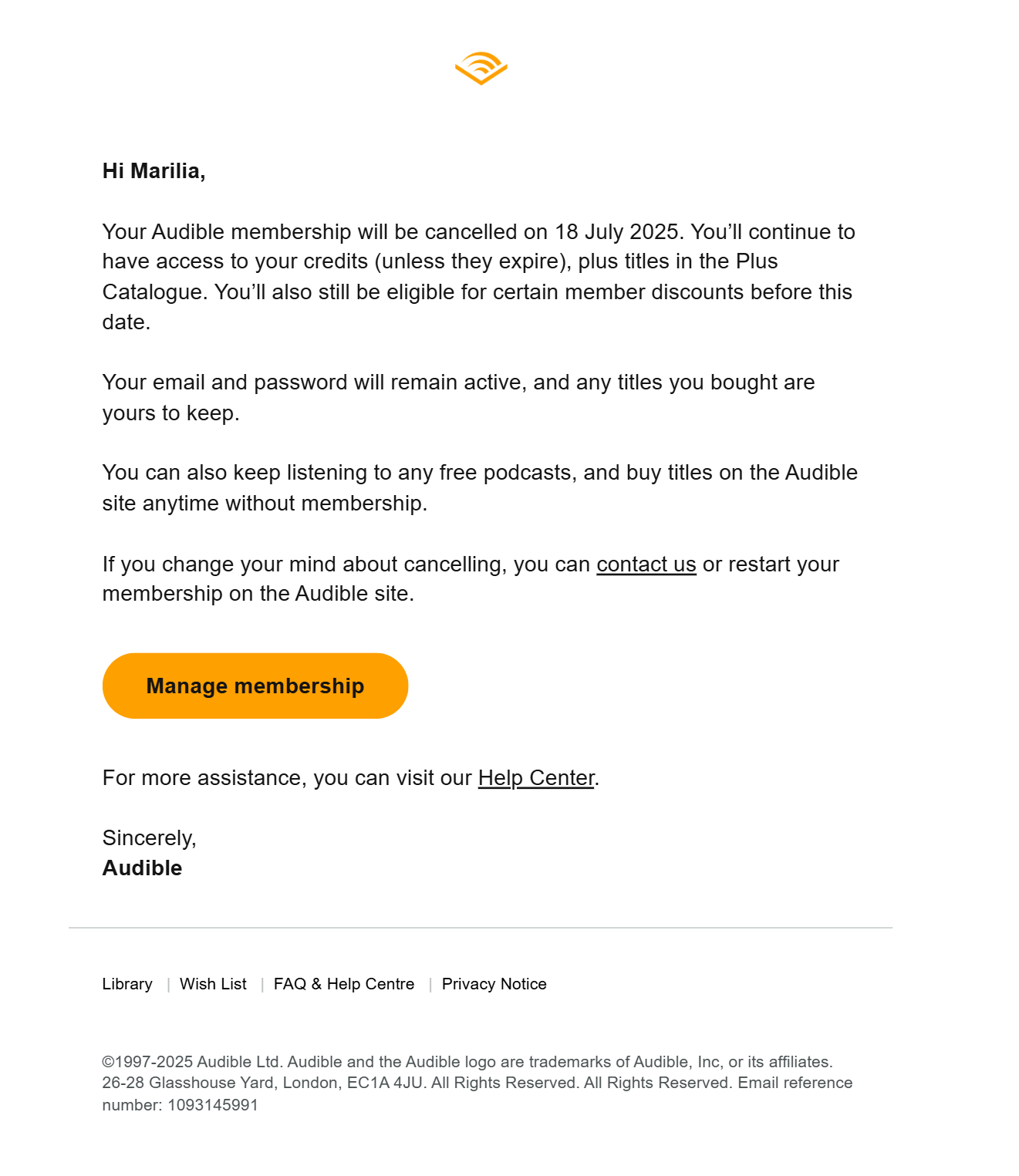
7. Internal cancellation emails
Internal cancellation emails are sent within a company or between business partners to cancel meetings, interviews, training sessions, projects, or collaborative plans. While these may not directly impact customers, they still reflect your professionalism and respect for others’ time.
Your messages should be concise and direct and include the next steps (if applicable), especially if something is rescheduled.
Internal communications cancellation template
Hi [Recipient’s Name],
I wanted to let you know that our [meeting/project/interview] scheduled for [Date/Time] has been canceled.
[Optional: Reason, if appropriate]
If needed, I’ll follow up with a new time or alternative plan. Let me know if you have any questions.
Thank you for understanding.
[Your Name]
Template example
This meeting cancellation email is short, clear, and easy to scan. It informs the team of the canceled meeting, provides context for the change, and sets expectations for a follow-up.
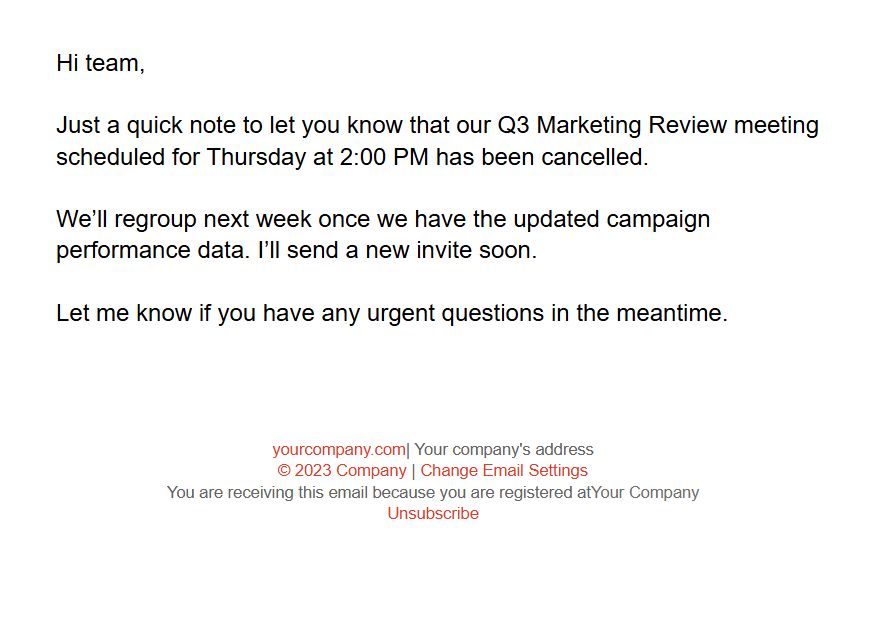
Cancellation Email Best Practices
A good cancellation email needs to be clear, concise, and helpful at first glance.
Below, let’s examine some best practices to help you craft cancellation messages that keep your audience informed and engaged.
Keep your cancellation email subject lines clear
Cancellation messages need to be fluff-free. This means you need to get straight to the point as fast as possible.
For that, use a straightforward subject line and open with the main message early on. For example, “Your event has been canceled” or “We’ve processed your subscription cancellation.”
Here are some subject line examples to use:
- Your Order #[Order Number] Has Been Canceled
- [Event Name] Has Been Canceled – Here’s What to Know
- We’ve Processed Your Cancellation Request
- Subscription Canceled Successfully
- Appointment Canceled – Reschedule Anytime
- Booking Canceled – Refund Details Inside
- We’re Sorry to See You Go
- You’ve Canceled Your [Order, Membership, Subscription]
Show empathy or gratitude in your email copy
Your cancellation message needs to acknowledge the inconvenience.
If the recipient initiated the cancellation, thank them for using your service. If you were the initiator, apologize briefly and show understanding.
Even when the news isn’t great, use a professional tone and offer a sincere apology. If it suits your brand, a touch of personality or warmth can go a long way.
Example: “We’re truly sorry for the change and understand this may cause frustration. Thank you for your patience.”
Offer alternatives
People appreciate instant solutions. So, when something gets canceled, you should provide alternatives to show that you care about them and ensure their experience is valued.
This is a simple way to reduce frustration, build trust, and even prevent churn. Here are a few alternatives you can include for different cancellation events.
- A new event date or reschedule option: Ideal for webinars, conferences, workshops, or personal appointments. Let attendees pick a new time or confirm the updated schedule with ease.
- Product recommendations: Useful for canceled orders or discontinued items.
- A “pause” option instead of full cancellation: Perfect for subscription services. Downgrading a plan or offering a discount can also be effective.
A thoughtful follow-up email shows that you’re customer-first, not transaction-first.
And remember, just because someone churns today doesn’t mean they won’t return later. Providing a great experience now can make all the difference when they’re ready to come back.
Include all the key details
Speaking of experience, avoid back-and-forth emails by providing all relevant information upfront. This may include:
- Cancellation date
- Refund or credit details
- Account or booking number
- Contact info for further assistance
While it’s essential to include these key details, always refrain from sharing full credit card numbers or any other sensitive personal information.
Example: “A full refund of [Sum] has been issued to your card ending in [xxxx]. It may take 5–7 business days to appear.”
Keep the design simple
When it comes to cancellation emails, less is more. Use plain text or a minimal design that puts the message at the center. This isn’t the time for flashy visuals or cluttered layouts, as they can distract from the purpose and feel tone-deaf in a message that’s already delivering not-so-great news.
Focus on a clean structure with plenty of white space. You can also use short paragraphs, bullet points, and bold headings to break up the content. If action is needed, include one clear and visible CTA button (e.g., “Update Preferences”, “Reschedule Now”, or “Explore alternatives”).
If you want to add graphics or banners, keep the layout clean, place key information at the top, and use a clear, minimal CTA.
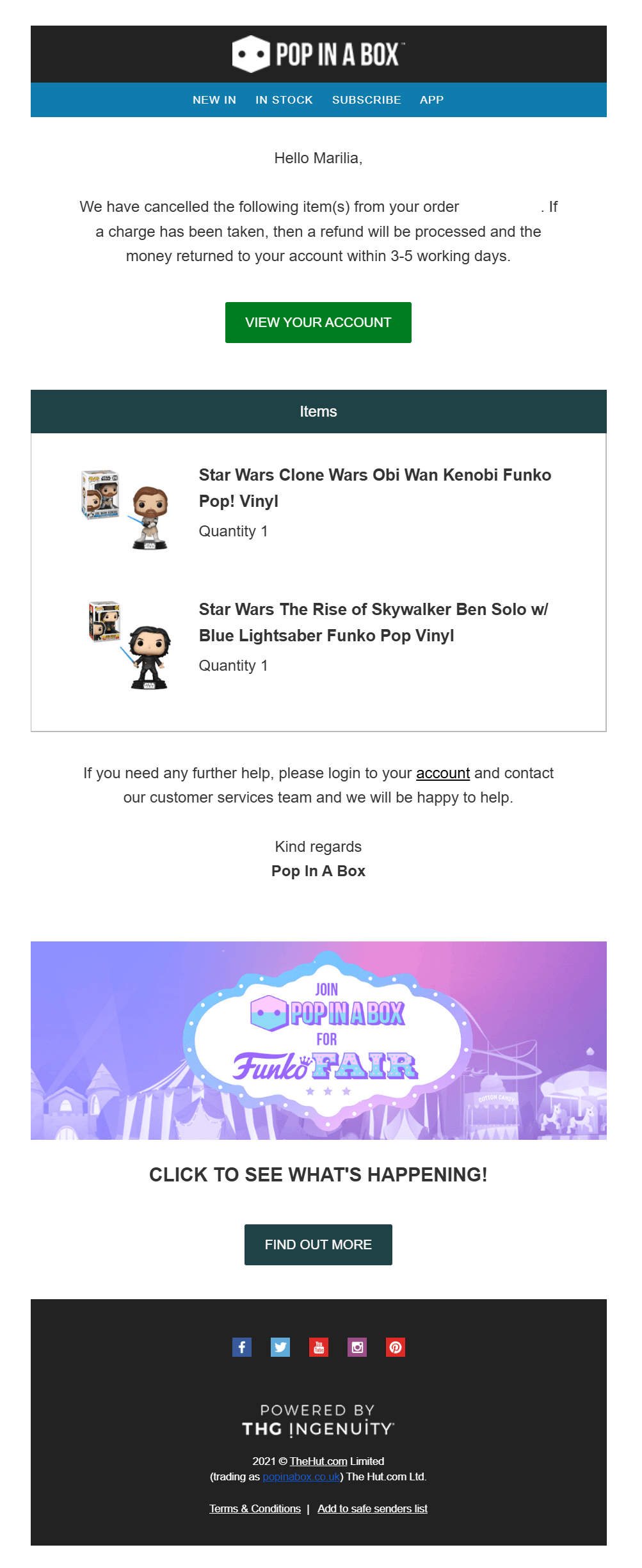
This personalized email from Pop In A Box demonstrates how to incorporate design elements without overwhelming the message. The visuals support the content rather than distract from it.
Canceled but not Churned
Cancellations may seem like the end of a customer journey, but with the right email, they can be the start of a better one.
Whether you’re confirming a canceled order, rescheduling an appointment, or canceling a subscription, every message you send is an opportunity to demonstrate to your customers that you value their time, trust, and experience with your brand.
By using clear copy, a thoughtful tone, and smart automation, you can promote retention and turn moments of friction into moments of loyalty.
If you’re looking for an easy way to create your cancellation emails, sign up for a free Moosend account. With just a few clicks, you’ll keep customers informed, engaged, and more likely to return.
FAQs
Below, you’ll find some common questions regarding cancellation emails.
1. How do you write a cancellation email politely?
Keep your tone friendly and professional. Start with a clear confirmation of the cancellation, acknowledge any inconvenience, and thank the recipient for their time or interest. If it makes sense, offer alternatives or next steps to stay helpful and supportive.
2. How do you respond to a cancellation email?
Respond promptly and with understanding. To avoid confusion, confirm that the cancellation has been processed, answer any specific questions, and thank the sender for letting you know. If appropriate, offer to reschedule or return at a later time.
3. How detailed should the cancellation reason be?
You don’t need to over-explain, but a short reason (e.g., scheduling conflict, low attendance, technical issues) helps provide context and show transparency. Focus more on what the recipient should know and what to expect next.




 Published by
Published by
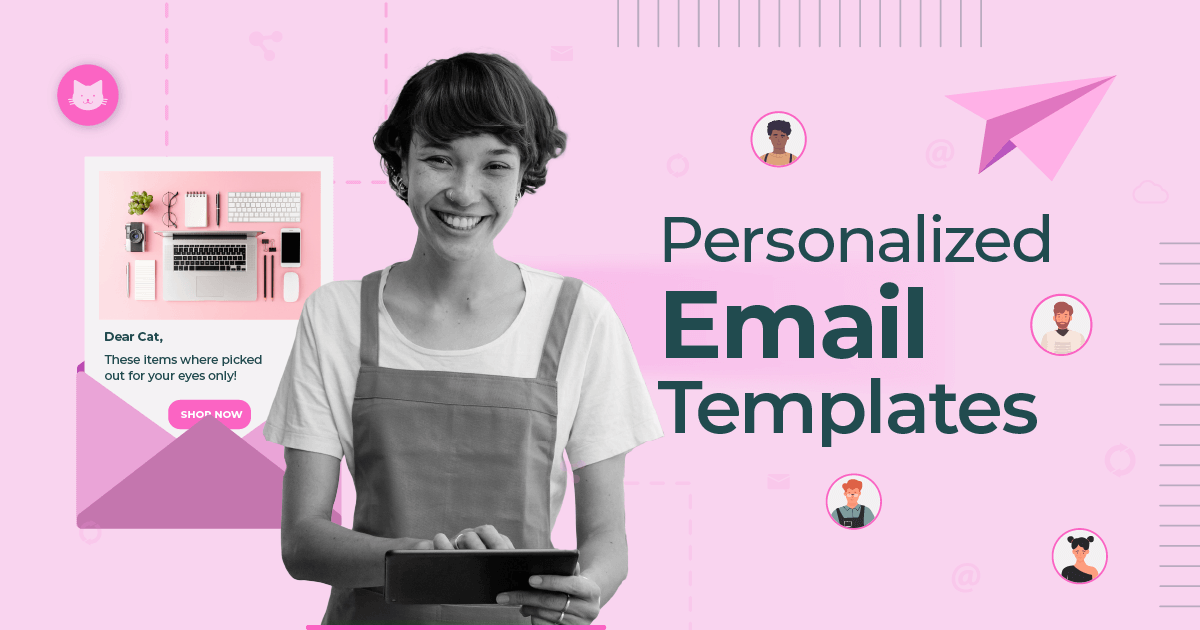
 Published by
Published by
